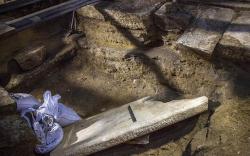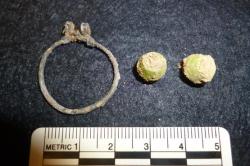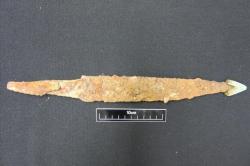INSTITUT SUPERIEUR D'ANTHROPOLOGIE
INSTITUTE OF ANTHROPOLOGY
ONLINE COURSES / COURS A DISTANCE
WINTER TERM : JANUARY 2015
REGISTER NOW
GRECE –  Amphipolis - Culture Ministry official Lina Mendoni revealed on Monday that it could take more than eight months for experts to complete test on the human remains found in the ancient tomb being excavated in Amphipolis, northern Greece. The ministry’s general secretary told Skai TV that authorities have not yet assigned the task of conducting the tests to a university or other organisation. Mendoni said that most of the field work at Amphipolis has been completed but that archaeologists still had plenty of work ahead in terms of assessing what has been found at the site.
Amphipolis - Culture Ministry official Lina Mendoni revealed on Monday that it could take more than eight months for experts to complete test on the human remains found in the ancient tomb being excavated in Amphipolis, northern Greece. The ministry’s general secretary told Skai TV that authorities have not yet assigned the task of conducting the tests to a university or other organisation. Mendoni said that most of the field work at Amphipolis has been completed but that archaeologists still had plenty of work ahead in terms of assessing what has been found at the site.
http://www.ekathimerini.com/4dcgi/_w_articles_wsite1_1_17/11/2014_544656
USA – Arkansas City - As an archaeologist, Blakeslee specializes in the history of the Great Plains, with a special interest on the Walnut River basin during all time periods. His current research could, in his words “rewrite the Great Bend culture.” The Great Bend Aspect, as archaeologists call it, refers to ancient Native American people who lived in several regions of the state, including Cowley County, from about 1425 AD to the early 18th century. Many Great Bend sites and artifacts have been identified in Cowley County and in the Ark City area in particular. Blakeslee’s latest research suggests that present-day Arkansas City covers the southern end of a massive settlement that covered at least a 5-mile stretch to the north. Spanish records from the 17th century that Blakeslee has examined suggest that perhaps as many as 20,000 people may have lived in the settlement at one time. Yet, very little of this settlement has been formally excavated. That’s where Blakeslee hopes the Ark City public will get involved. He proposes an archaeological survey to look for remains of the ancient city, beginning in the spring of 2015.
http://www.winfieldcourier.com/news/article_99cdbe5e-6f9e-11e4-a761-2b2fdefc75ba.html
ROYAUME UNI –  Hunterston Sands - Archaeologists have unearthed a fascinating and unusual find at Hunterston Sands. A group of large oak timbers thought to be from an 800-year-old dismantled timber tower has been discovered buried in the sand.;The site was discovered during a research survey.Known as the ‘COALIE’ project – Coastal Archaeological Landscapes: Intertidal and Estuarine – work is focused on the coastal and marine heritage of the North Ayrshire coast between Ardrossan and Largs, investigating sites such as abandoned harbours, beacons, shipwrecks and fishtraps. The timbers found at Hunterson have been dated using tree rings in the oak which suggest at least one of the timbers is around 800 years old, making this a very unusual find. Time team boffins say the timbers have the potential to reveal much about the nature of the building they were part of, about the woodland they were cut from and about historic carpentry from a lost age. The site – a strategic coastal position during the reign of Alexander II in the early 13th century AD – is located on the estate of one of Scotland’s oldest families, the Hunters, adding to the mystery and potential importance of the remains. Clearly visible from the air, the boulder banks cover an area of at least 500 square metres and archaeologists believe they previously marked the edge of the coast, when the vegetated saltmarsh on Hunterston Sands was much more extensive. The wet coastal environment has preserved the timbers in excellent condition despite some evidence of attack by marine boring organisms and surface weathering. Each massive timber is a naturally-grown oak which has been halved lengthways with a complex series of angled joints and carpentry worked into the end of the timbers. They are all at least 2m long and around 0.5m wide; the close similarity of the carpentry suggests they are from the same original structure, later dismantled or reused. In addition, a large, mysterious hexagonal, stone-built harbour on the very tip of Brigurd Point, was surveyed and dived on during a very low-tide. The harbour is around 60m wide and could have accommodated a number of boats but bizarrely only at low-tide.No diagnostic features were found within the structure to provide clues on the age or specific function of the harbour; it is believed to pre-date available historic documents so may be at least of medieval age. Dr Andy Bicket, Senior Archaeologist and Geoarchaeologist for Wessex Archaeology, Coastal and Marine said: “This represents an incredibly rare and exciting find. “The Firth of Clyde has long been an important maritime route from early prehistory to the present day and we have rare and fascinating pieces of the historic seascape preserved in Hunterston Sands. “The early 13th century was a key period for defining Scotland and the west coast seaways were instrumental in the strategies of the various factions vying for control. “The structures on Hunterston Sands also highlight that managing coastal change has long been an important issue for people”.
Hunterston Sands - Archaeologists have unearthed a fascinating and unusual find at Hunterston Sands. A group of large oak timbers thought to be from an 800-year-old dismantled timber tower has been discovered buried in the sand.;The site was discovered during a research survey.Known as the ‘COALIE’ project – Coastal Archaeological Landscapes: Intertidal and Estuarine – work is focused on the coastal and marine heritage of the North Ayrshire coast between Ardrossan and Largs, investigating sites such as abandoned harbours, beacons, shipwrecks and fishtraps. The timbers found at Hunterson have been dated using tree rings in the oak which suggest at least one of the timbers is around 800 years old, making this a very unusual find. Time team boffins say the timbers have the potential to reveal much about the nature of the building they were part of, about the woodland they were cut from and about historic carpentry from a lost age. The site – a strategic coastal position during the reign of Alexander II in the early 13th century AD – is located on the estate of one of Scotland’s oldest families, the Hunters, adding to the mystery and potential importance of the remains. Clearly visible from the air, the boulder banks cover an area of at least 500 square metres and archaeologists believe they previously marked the edge of the coast, when the vegetated saltmarsh on Hunterston Sands was much more extensive. The wet coastal environment has preserved the timbers in excellent condition despite some evidence of attack by marine boring organisms and surface weathering. Each massive timber is a naturally-grown oak which has been halved lengthways with a complex series of angled joints and carpentry worked into the end of the timbers. They are all at least 2m long and around 0.5m wide; the close similarity of the carpentry suggests they are from the same original structure, later dismantled or reused. In addition, a large, mysterious hexagonal, stone-built harbour on the very tip of Brigurd Point, was surveyed and dived on during a very low-tide. The harbour is around 60m wide and could have accommodated a number of boats but bizarrely only at low-tide.No diagnostic features were found within the structure to provide clues on the age or specific function of the harbour; it is believed to pre-date available historic documents so may be at least of medieval age. Dr Andy Bicket, Senior Archaeologist and Geoarchaeologist for Wessex Archaeology, Coastal and Marine said: “This represents an incredibly rare and exciting find. “The Firth of Clyde has long been an important maritime route from early prehistory to the present day and we have rare and fascinating pieces of the historic seascape preserved in Hunterston Sands. “The early 13th century was a key period for defining Scotland and the west coast seaways were instrumental in the strategies of the various factions vying for control. “The structures on Hunterston Sands also highlight that managing coastal change has long been an important issue for people”.
http://www.ardrossanherald.com/news/roundup/articles/2014/11/18/516194-interesting-find-in-hunterston-sands/
ROYAUME UNI – 
 Exning - Twenty one skeletons of Anglo Saxon people have been found – just one foot under the ground – during an archaeological dig in Exning. The skeletons were found on land at Burwell Road in Exning, alongside a spear, a glass bowl, gold plated brooches, a cloak pin, and a dagger, some of which is thought to have come from as early as 7AD. Exning has strong links to King Anna, who converted to Christianity in the early 7th century, and is reportedly the birthplace of Queen Etheldreda, his daughter, who had Ely named after her.
Exning - Twenty one skeletons of Anglo Saxon people have been found – just one foot under the ground – during an archaeological dig in Exning. The skeletons were found on land at Burwell Road in Exning, alongside a spear, a glass bowl, gold plated brooches, a cloak pin, and a dagger, some of which is thought to have come from as early as 7AD. Exning has strong links to King Anna, who converted to Christianity in the early 7th century, and is reportedly the birthplace of Queen Etheldreda, his daughter, who had Ely named after her.
http://www.cambridge-news.co.uk/pictures/Anglo-Saxon-graves-excavation-Burwell-Road-Exning/pictures-24545264-detail/pictures.html